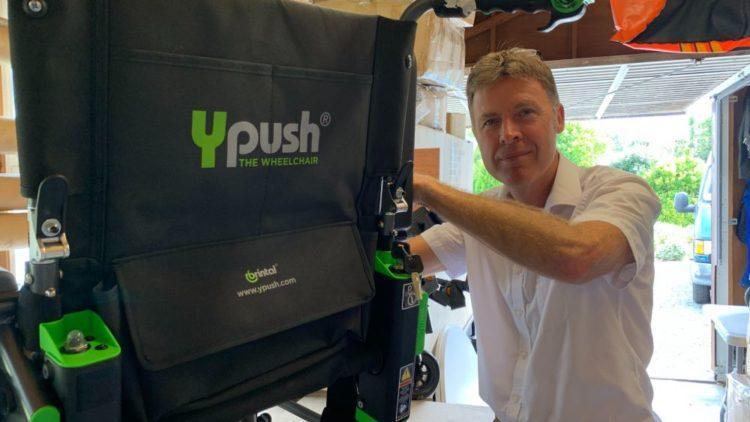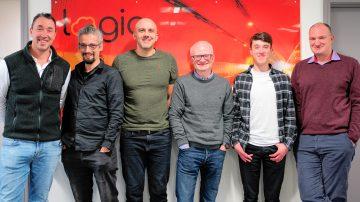Guernsey-based inventor Brian Harrison always knew he wanted to create something that would improve peoples’ lives. And after years of hard work, the Ypush wheelchair has finally been unveiled. Brian spoke to Channel Eye about its journey
It’s incredible to think that in a humble garage in St Andrew’s, Guernsey, a product was invented that will positively impact on the lives of thousands, if not millions of people all over the world.
A wheelchair that is unlike any other currently on the market.
But that’s exactly what’s about to happen, when Ypush wheelchairs begin rolling off the production line (pun absolutely intended here) in the next few months.
Years of false starts
You’re probably looking at it, wondering what makes it so special. And that unassuming charm is part of what’s so wonderful about it. It looks like an ordinary wheelchair but it contains many unique components that are a game-changer for wheelchair users and their carers.
Its unique braking system means that when the carer lets go of the handles, the wheels lock, preventing accidents. It has tyres that can’t puncture and an anti-tip system, keeping it stable. It’s also lightweight and looks just like a conventional wheelchair. If you woke up tomorrow and were told you had to use a wheelchair for the rest of your life, you would want that to be a Ypush.
For Brian Harrison it represents years of false starts, literally going back to the drawing board, waste paper bins filled with screwed up sheets of ideas that were almost, but not quite there.
A curious mind
He began working on the Ypush back in 2013 after a visit to see his godmother.
“I remember vividly standing in the window of her apartment which is on Poole Quay. I saw a lady with a free-wheel walker. She was walking along and she kept hesitating, looking behind, and I wondered why.
“I thought that perhaps she was concerned about how far she could go before she got too tired to go back. She stopped and sat down and I thought maybe she didn’t have the energy to go back. I started developing an idea that it would be really cool to develop a new mobility product that supported you to walk ,but if you got too tired you could convert it into a scooter and scoot back to where you’d come from so you weren’t stranded. And that was where the whole idea started.
“From that moment I started trying to think of solutions that were lightweight and could be used for mobility products. I got hooked on learning about how electric motors work, and suddenly got really fascinated about the idea of getting people moving using lightweight mobility products.”
The first product he built was called an i-Glider which worked on the principles he’s described. But after a few years he adapted the idea further.
“The concept was the same, all the basics of the engineering were the same, to build something lightweight which had wheel motors that could freewheel but also had power assistance and something that was suitable for people to use in that environment, and that’s what led in the end to the Ypush.”
Ground-breaking innovation
Brian quickly realised that there wasn’t any other product in the motorised wheelchair market like his.
“We had already started developing the technology of a freewheeling motor that’s really powerful and that’s the difference between the Ypush and any other mobility products that are out there. Most of them are controlled by the person that’s driving it by a joystick but when they let off the joystick and they slow down, the wheels lock.
“That’s quite a complicated engineering thing to understand. It’s like locking the gearbox on a car, if it’s in gear you can’t push it. And what we needed to do was develop something which you could push, but you could also power when needed as well, but we didn’t want to have to change any settings. That’s the whole point. It had to be this seamless power, a bit like you’ve got on electric bicycles. But none of those products and none of those bicycles have got a lot of power from standstill.
“We realised that we had to create this technology where you could have a wheel with a motor hidden inside it, with no gearbox that can also freewheel at any time. Most importantly, so when you press the accelerator from absolute zero RPM, it has this intense power – enough to push 100kg + up a hill.
If you understand that, you understand the difference between this and anything else that’s come before, because it’s solved that problem. You need that free-wheeling on the Ypush, because if you’re going to pull it backwards and forwards like a manual wheelchair and stick it on a hill, it just needs to be able to feed in seamless power at any time without being locked into a gear. Also if you are walking along at say, 2mph and you press the throttle to go up a hill, the controller needs to read the exact speed you are already going. Sounds simple, but this is the big hurdle to overcome.”
Back to the lab – again
If this was a movie, the ‘montage’ part would kick in at this point and we’d see lots of cut shots of Brian working on many, many versions of the many, many components of the Ypush before finally coming up with something that worked. You’d see the blood, sweat and tears progression take place over about 15 seconds, accompanied by an uplifting soundtrack.
The reality was somewhat different.
“It took three years to get that to work and it was in degrees, it wasn’t just one day. We’d try different motor configurations and it would be barking like a dog when you’re trying to use it – that’s the noise the motor would sometimes make. Or it would be really rough or it didn’t have any power or it would set itself on fire. It just didn’t work. The years went by, summers became winters, the kids went from being small to being large and we still hadn’t sorted it. It wasn’t just like a long weekend painting the spare room.”
How many iterations did it go through, I ask?
“I think with the motors there were hundreds, because every little thing had to be changed over and over again. There’s probably 50 or 60 components inside each wheel motor and each one of them we had to design it, but then you’d test it and then you’d have to test it and change it again and it has a knock-on effect on the next thing. I got in touch with just about every motor and manufacturer in the world to try to understand what was happening.
“So not only is it getting a motor to work, but it’s building it inside a wheel, and that not only has to work, it has to be really strong as well. There’s so much that can go wrong and does go wrong until you get to a point where it works.”
And it was like that with every element, every component of this very sophisticated piece of technology. Seven years of doing it wrong, until eventually one day everything was right. Was there ever a point where he had the ‘Eureka’ moment?
“It’s difficult to explain because in my office, I use old fashioned card folders and each one of them has a mechanism written on it. It grew from being one folder ‘’Ypush project’’, to literally about 60.
“Everything builds into this massive great big… somebody said to me ‘so it doesn’t get too overwhelming you’ve just got to try and think about one thing at a time, and try and do an improvement on that and then move onto the next thing, because if you think of the whole thing, you’ll never cope.”
In Friday’s ChannelEye, Brian explains how inventing the Ypush was only one of the hurdles to overcome. Once they had a world-class invention, the next challenge was finding the investment to take this life-changing invention to production and eventually to market.













